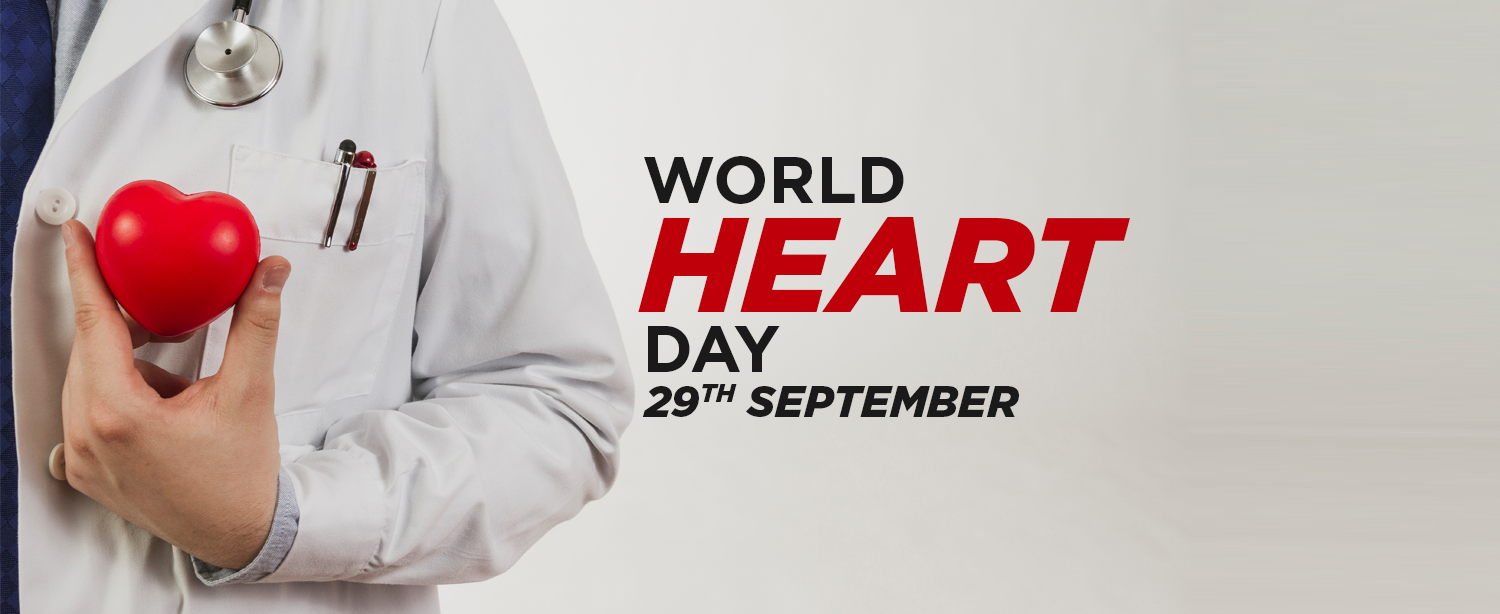World Heart Day is observed across the world on 29th September. It is observed to spread the message of maintaining a healthy heart amongst people. Globally cardiovascular diseases are the leading cause of death claiming 17.5 million lives each year. The day aims to make people aware about how to control and prevent heart diseases. Controlling risk factors like tobacco use, unhealthy diet and physical inactivity can avoid 80% of premature deaths from heart diseases.
Cardiovascular (CVD) disease is the world’s number one killer today. It is time we change these statistics. By making just a few small changes to our lives, we can reduce our risk of heart disease. The theme for this year is for my heart, for your heart, for all our hearts. This means to make a promise to take steps to improve your heart health as well as of other around you.
Be regular in your medical check ups:
- Check your blood glucose levels: High blood sugar can be indicative of diabetes.
- Check your numbers: Measure your cholesterol, weight, body mass index regularly as well as your blood pressure and blood sugar levels. Your doctor can advise you on your CVD risk and help you improve your heart health.
Understand the signs and symptoms of a heart attack. Over 70% of all cardiac and breathing emergencies occur in the home when a family member is present and could help a victim. Talk to your healthcare professional about cardiopulmonary resuscitation (CPR) courses so you can help a loved-one in the event of a heart attack.
Some heart attacks are sudden and intense. But most start slowly, with mild pain or discomfort. Here are some signs of a heart attack:
- Chest discomfort. Most heart attacks involve discomfort in the center of the chest that lasts more than a few minutes – or it may go away and then return. It can feel like uncomfortable pressure, squeezing, fullness or pain.
- Discomfort in other areas of the upper body. Symptoms can include pain or discomfort in one or both arms, the back, neck, jaw or stomach.
- Shortness of breath. This can occur with or without chest discomfort.
- Other signs. Other possible signs include breaking out in a cold sweat, nausea or light headedness.
Symptoms vary between men and women. As with men, women’s most common heart attack symptom is chest pain or discomfort. But women are somewhat more likely than men to experience some of the other common symptoms, particularly shortness of breath, nausea/vomiting, and back or jaw pain.
Do not waste a minute, call for emergency medical help if someone around you is having a heart attack.
Some facts about heart diseases:
- Heart disease is also known as cardiovascular disease (CVD) or coronary heart disease (CHD) and includes illnesses associated with the heart and vessels.
- Heart attacks occur when oxygen-rich blood is blocked and can’t flow to the heart. The section of the heart devoid of oxygen begins to die if the flow isn’t restored in a sufficient amount of time.
- There are many types of heart disease, including: hypertension (high blood pressure), coronary heart disease (heart attack), and cerebrovascular disease (stroke).
- It is predicted that by 2030, almost 23.6 million people will die from a type of heart disease globally.
- Alcohol and stress can also increase cardiovascular risk.
Health tips to prevent heart diseases:
1. Cholesterol levels:
High blood cholesterol is a major risk factor for heart disease. Preventing and treating high blood cholesterol includes eating a diet low in saturated fat and cholesterol and high in fiber, keeping a healthy weight, and getting regular exercise. All adults should have their cholesterol levels checked once every five years. If yours is high, your doctor may prescribe medicines to help lower it.
2. Prevent and control high blood pressure:
Lifestyle actions such as healthy diet, regular physical activity, not smoking, and: healthy weight will help you to keep normal blood pressure levels and all adults should have their blood pressure checked on a regular basis. Blood pressure is easily checked. If your blood pressure is high, you can work with your doctor to treat it and bring it down to the normal range.
3. Control diabetes:
People with diabetes have an increased risk of heart disease but can reduce their risk through weight loss and regular physical activity.
4. No tobacco:
Smoking increases the risk of high blood pressure, heart disease, and stroke. Never smoking is one of the best things a person can do to lower their risk. And, quitting smoking will also help lower a person’s risk of heart disease.
5. Moderate alcohol use:
Excessive alcohol use increases the risk of high blood pressure, heart attack, and stroke. People who drink should do so only in moderation and always responsibly.
6. Maintain a healthy weight:
Healthy weight status in adults is usually assessed by using weight and height to compute a number called the “body mass index” (BMI). BMI usually indicates the amount of body fat. An adult who has a BMI of 30 or higher is considered obese. Overweight is a BMI between 25 and 29.9. Normal weight is a BMI of 18 to 24.9. Proper diet and regular physical activity can help to maintain a healthy weight.
7. Regular physical activity:
Adults should engage in moderate level physical activities for at least 30 minutes on most days of the week.
8. Diet and nutrition:
Along with healthy weight and regular physical activity, an overall healthy diet can help to lower blood pressure and cholesterol levels and prevent obesity, diabetes, heart disease, and stroke. This includes eating lots of fresh fruits and vegetables, lowering or cutting out added salt or sodium, and eating less saturated fat and cholesterol to lower these risks.
The best heart healthy exercises:
- Suryanamaskar – This yoga move will strengthen the upper body and keep it supple. The repetitive movement of going up from the ground to standing is a great heart-pumping exercise.
- Swimming – Water can be a great medium to give you a super effective cardiovascular workout. It is a safe and intense workout.
- Cycling – The continuous non-impact pedalling can place smooth and constant tension on the leg muscles and make the heart work as hard as you want it to.
Whether its chest pain or discomfort or you want a second opinion regarding a heart surgery. Consult our expert Cardiologists at the Centre for Cardiac Sciences. Please find below link for more details:
https://www.kokilabenhospital.com/departments/centresofexcellence/centrefor_cardiacsciences.html


